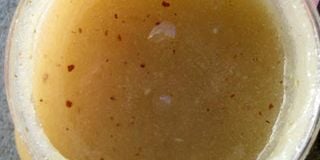The wonder oil of the North

Moo-yaa gives food an admirable aroma. It can be bought in different restaurants that serve traditional Northern cuisine or groceries in districts in the north.
What you need to know:
The butter extracted from the shea tree forms a great part of the northern cuisine as it is often added to different meals or eaten independently as a cream of sorts.
As ghee is to the Banyankole so is Moo-yaa (Shea butter) to the Acholi. It is a brown cream extracted from seeds of a wild deciduous Karite or Shea tree locally called yaa which largely grows in the northern region of the country. The name simply means oil from the yaa tree.
Back in the day when boiled food the order of the kitchen, the oil was discovered as an additive because of its aromatic property that cuts through even the stuffiest of tastes.
According to Lawil Opobo an elderly Acholi, it was also used by women to impress their husbands when they were back from hunting trips especially among co-wives. “It was believed that the aromatic scent of the food cooked with moo-yaa would lure the husband to the hut serving the meal,” she says.
It was also and still is an important necessity during traditional marriage as it is served to the in-laws as a sign that the bride is aware of her roots and that she is able to cook for her future husband.
Moo-yaa can be eaten directly with cassava, sweet potatoes or is added to food as it was being prepared. It can also be used to prepare other sauces like lalwinya (a mixture containing peanut butter), dek-ngor among others. This shortening is served at almost every restaurant that specializes in traditional foods and at different homes.
Ms Caroline Ojwach who loves moo-yaa says like many people, she prefers adding it to beans though it can also be added to greens to give a unique taste. She uses traditional methods to prepare dishes with the butter. Other tribes that enjoy moo-yaa are the Ateso who locally call it emuna, the Langi and those from West Nile.
Extracting the butter locally
To get moo-yaa from the seeds you will need a motor, grinding stone, a sauce pan and a fire, according to Ojwach.
•The brown Shea nuts are washed and dried then roasted preferably over burnt firewood to remove the outer coats.
•They are then crushed and mixed with sand or ash (to prevent them from burning).
•After about 30 minutes, the roasted seeds are washed separating it from sand, dried and left to cool.
•These seeds are then pounded in a mortar to form a paste which is later grinded on a grinding stone locally called kidii (Acholi) to form a fine paste.
•This paste is put in boiling water until its oil forms an immiscible layer at the top.
•The oil is carefully decanted into a clean container. Note: Don’t let the oil mix with bottom contents because it will affect the taste making it bitter. The bottom contents are locally used as wood preservative.
•The oil is left to cool, making sure it’s free from any debris for at least a day then it’s ready for use.




